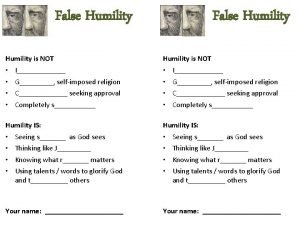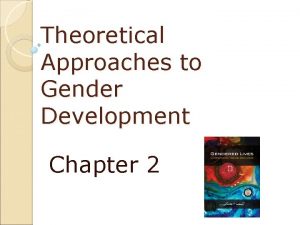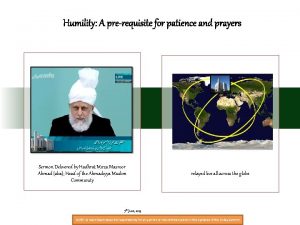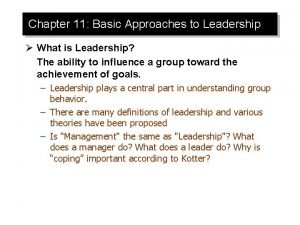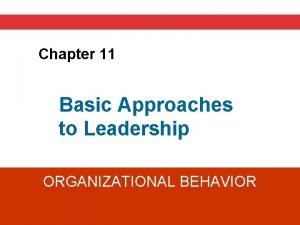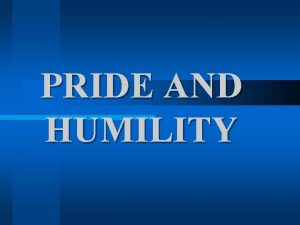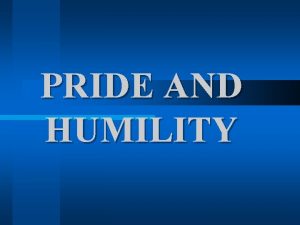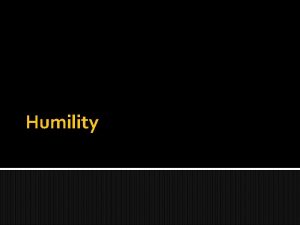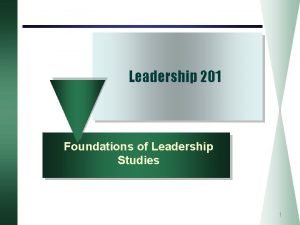Theoretical approaches on humility and leadership New theoretical





















- Slides: 21

Theoretical approaches on humility and leadership New theoretical (thinking, studies and theories) approaches on humility and leadership are emerging in psychology and business ethics These theoretical approaches support an assertion that humility contributes towards effective leadership – this links to vulnerable leadership and how it connects leaders with others This thinking can encourage us to think about how humility can support us to learn lessons from individuals’ concerns, complaints and experiences of injustice, as well as how we can prevent them in the first instance, to change and improve future social care and health services

Before we explore some theoretical approaches to humility, it is helpful to set the scene as regards social care and health practice and responses to individuals’ concerns and complaints: - Your organisation should have processes (informal and formal) to enable individuals and carers to express their concerns and complaints so that these can be addressed and resolved effectively - this includes reporting experiences of injustice and the violation of human rights and dignity - Social Care Institute for Excellence (SCIE) has several resources to help you consider how to deal with concerns and complaints and to prevent them in the first place. This includes a resource called ‘Complaints: Ideas You Can Use’

Part 15 of The Regulated Services (Service Providers and Responsible Individuals) (Wales) Regulations 2017 contains: Complaints policy and procedure 64. —(1) The service provider must have a complaints policy in place and ensure that the service is operated in accordance with that policy. (2) The service provider must have effective arrangements in place for dealing with complaints including arrangements for (a) identifying and investigating complaints; (b) giving an appropriate response to a person who makes a complaint, if it is reasonably practicable to contact that person; (c) ensuring that appropriate action is taken following an investigation; (d) keeping records relating to the matters in subparagraphs (a) to (c). (3) The service provider must provide a summary of complaints, responses and subsequent action to the service regulator within 28 days of being requested to do so. (4) The service provider must (a) analyse information relating to complaints and concerns; and (b) having regard to that analysis, identify any areas for improvement.

Part 17 of The Regulated Services (Service Providers and Responsible Individuals) (Wales) Regulations 2017 contains requirements on responsible individuals for ensuring the effective oversight of the service. Other reports to the service provider 75. —(1) The responsible individual must, without delay, report to the service provider— (a) any concerns about the management or provision of the service; (b) any significant changes to the way the service is managed or provided; (c) any concerns that the service is not being provided in accordance with the statement of purpose for the service. (2) But this requirement does not apply where the service provider is an individual.

We will now have an introduction to theoretical approaches on humility This is to consider how these approaches might support a positive response to individuals’ concerns or complaints

What characteristics might you associate with being a humble leader? What are the potential benefits and risks of adopting this type of approach?

What are theoretical approaches on humility and how do they relate to leadership? Owens et al. 2013 discuss leadership humility as something that integrates selfawareness, teachability and appreciation of the capabilities of others. Teachability is linked to a commitment to lifelong learning and a leader’s admission that they do not have all of the answers – this means that a leader must be willing to acknowledge and respect others’ expertise and contributions (this is relevant to your previous work on co-production) Leaders with humility willingly give their power to others in the recognition that this empowers others, strengthens the competence (capabilities) of others and builds trust and commitment (Argandona, 2015; Owens and Hekman, 2016)

Cultural Humility and Leadership Reference is made to cultural humility which symbolises a lifelong commitment to self-evaluation (assessment) and critique (analysis or assessment) to address power imbalances between a professional and individual to develop mutually beneficial relationships (Foronda et al. 2016) It is argued that humble leaders must first learn to look within themselves and humbly and thoughtfully assess not only their strengths but also their weaknesses – this careful self-assessment enhances the ability of a leader to define reality and prepare to lead others (Caldwell et al. 2017)

Cultural Humility and Leadership Foronda et al. 2016 describe four qualities that they associate with cultural humility: 1. Openness and a willingness to explore new ideas that are based on a commitment to share power 2. Self-awareness of one’s strengths, limitations, values, beliefs, behaviours and the way that one comes across to others

Cultural Humility and Humility 3. Egoless which means being modest and enacting (supporting) a belief system based on equality and human rights 4. Supportive interaction which results in sharing and positive human exchanges

Cultural Humility and Leadership Foronda et al. 2016 reviewed literature on cultural humility and they stated that the consequences of cultural humility were found to be: - Mutual empowerment Respect Optimal (the best) care Trust Collaboration A continuous process of self-reflection and lifelong learning

Leadership Humility and Teams Rego et al. 2017 refer to expressed humility in teams which involves: 1. Admitting mistakes and limitations 2. Spotlighting team members’ strengths and deflecting praise to others 3. Being teachable (such as being willing to learn and change one’s thinking)

Leadership Humility and Services Caldwell et al. 2017 assert that there are twelve dimensions that enable humble leaders to contribute to an organisation’s success (this is relevant to service delivery) based on diverse authors’ studies: 1. Self- knowledge and self-awareness 2. Teachability and being willing to admit that we are not expert in all areas 3. Acknowledgment of personal limitations and how to minimise their negative effects. This includes the need to empower and engage others to achieve successful outcomes

4. A commitment to constantly learn and improve 5. Dedication to a higher objective that transcends (goes beyond) self-interest, e. g. individuals’ wellbeing outcomes 6. Acceptance of personal responsibility and accountability for the achievement of results and outcomes 7. Willingness to share credit for achievements 8. Commitment to the empowerment of others to enable others to succeed

9. An understanding of the big picture and where one fits in, including the importance of treating others as valued partners 10. Recognition of the need to serve others – humility shows respect and reverence (admiration) for others 11. Willingness to empower others based on a recognition that others may be better placed to deal with something as opposed to oneself 12. An integrated sense of ethical awareness – humility requires ethical leadership, a concept that you have studied elsewhere on this award

Benefits and Risks to Leadership Humility Leadership humility has strong links with vulnerable leadership (Brown, 2010; Ito and Bligh, 2016) and you have been introduced to some potential benefits of leadership humility However, there are risks which include: - Not everyone responds to leadership humility well – some see it as a weakness - Leadership humility being seen as manipulation, to get people on side but not for the right reasons - Being insincere, e. g. a ‘humble leader’ who keeps apologising but does not learn and improve upon what has gone wrong, to the continued detriment of individuals

Conclusion We will conclude with some thoughts on how theoretical approaches on humility can support a positive response to individuals’ concerns and complaints: - Enables social care and health leaders, managers and staff to recognise that as humans we are fallible (imperfect) and so invariably things will go wrong and we can get things wrong - Supports the saying, “It’s not what goes wrong, but how we deal with it that matters” - Supports an honest approach in our communication with individuals and carers, to work out how to put things right, prevent a repeat of the situation and make improvements for the future

- Values, attitudes and behaviours that come from a position of humility mean that leaders, managers and staff should be honest about what they do not know and where they need help - This requires the empowerment of others to provide their perspectives and expertise, including individuals and carers who have identified their wellbeing outcomes and what they want to achieve - Humility supports a teachable culture which symbolises a commitment to lifelong learning and an ongoing need to reflect and evaluate (assess) what happened, why and what could be done differently next time - Leadership humility reflects a preventative approach to individuals’ concerns, complaints and experiences of injustice through the generation of trust and equity that echoes with co-production

We hope that you have found this presentation on theoretical approaches to humility to be useful to your thinking on responding positively to individuals’ concerns or complaints

References Argandona, A. (2015) ‘Humility in management’, Journal of Business Ethics, 132(1), pp. 63 -71. Proquest Psychology Database [Online]. Available at: http: //www. proquest. com/products-services/pq_psychology_journ. html (Accessed: 27 November 2017). Brown, B. (2010) The power of vulnerability. Available at: https: //www. ted. com/talks/brene_brown_on_vulnerability (Accessed: 1 December 2017). Caldwell, C. , Ichiho, R. and Anderson, V. (2017) ‘Understanding level 5 leaders: the ethical perspectives of leadership humility’, Journal of Management Development, 36 (5), pp. 724 -732. Emerald Insight [Online]. Available at: http: //emeraldinsight. com/ (Accessed: 27 November 2017). Foronda, C. , Baptiste, D. , Reinholdt, M. and Ousman, K. (2016) ‘Cultural humility: a concept analysis’, Journal of Transcultural Nursing, 27 (3), pp. 210 -217. SAGE Journals [Online]. Available at: http: //journals. sagepub. com/ (Accessed: 27 November 2017). Ito, A. and Bligh, M. (2017) ‘Feeling vulnerable? Disclosure of vulnerability in the charismatic leadership relationship’, Journal of Leadership Studies, 10 (3), pp. 66 -70. Wiley Online Library [Online]. Available at: http: //onlinelibrary. wiley. com/ (Accessed: 1 December 2017). Owens, B. , Johnson, M. and Mitchell, T. (2013) ‘Expressed humility in organizations: implications for performance, teams and leadership’, Organization Science, 24, pp. 1517 -1538.

References Owens, B. and Hekman, D. (2016) ‘How does leader humility influence team performance? Exploring the mechanisms of contagion and collective promotion focus’, Academy of Management Journal, 59 (3), pp. 1088 -1111. EBSCO Business Source Premier [Online]. Available at: https: //www. ebsco. com/products/research-databases/business-source -premier (Accessed: 27 November 2017). Rego, A. , Owens, B. , Leal, S. , Melo, A. , Cunha, M. Goncalves, L. and Ribeiro, P. (2017) ‘How leader humility helps teams to be humbler, psychologically stronger, and more effective: a moderated mediation model’, The Leadership Quarterly, 28, pp. 639 -658. Science Direct [Online]. Available at: http: //www. sciencedirect. com/ (Accessed: 27 November 2017).
 Humility meaning
Humility meaning Brown and clough group living
Brown and clough group living Psychodynamic theories definition
Psychodynamic theories definition Proverbs about pride and humility
Proverbs about pride and humility Examples of humility
Examples of humility Fnha cultural safety and humility
Fnha cultural safety and humility Trait approaches to leadership
Trait approaches to leadership A remarkable turnaround case study
A remarkable turnaround case study How do charismatic leaders influence followers
How do charismatic leaders influence followers Basic approaches to leadership
Basic approaches to leadership Basic approaches to leadership
Basic approaches to leadership Basic approaches to leadership
Basic approaches to leadership Trò chơi âm nhạc
Trò chơi âm nhạc What knee do you genuflect on
What knee do you genuflect on Cultural humility definition
Cultural humility definition Cultural humility ted talk
Cultural humility ted talk Clothe yourselves with humility
Clothe yourselves with humility Unity through humility
Unity through humility Heart is pure meaning
Heart is pure meaning Philippians 2:1-30
Philippians 2:1-30 Capable individual
Capable individual Humility prayer aa
Humility prayer aa
